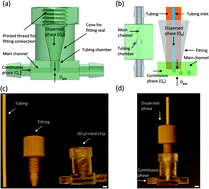Droplet generation in cross-flow for cost-effective 3D-printed “plug-and-play” microfluidic devices†
Abstract
Droplet-based microfluidics is a rapidly growing field of research and involves various applications from chemistry to biology. Droplet generation techniques become the pre-requisite focus. Additive manufacturing (3D printing) technology has recently been exploited in microfluidics due to its simplicity and low cost. However, only relatively large droplets can be produced in current 3D-printed droplet generators, due to the channel dimension limitations on how fine a channel can be 3D-printed. Here we report a novel design of a 3D-printed “plug-and-play” device for the generation of monodisperse microdroplets with sizes down to ∼50 μm. This device combines a 3D-printed generator, a commercial tubing and a fingertight fitting, which can be easily assembled and disassembled. Different emulsions, water-in-oil and oil-in-water, can be generated in the same device. Scaling laws for droplet sizes generated in our device have been successfully proposed and verified. Furthermore, the feasibility of 3D printing technology used in droplet-based engineering applications has been demonstrated by two novel 3D-printed devices, as well as by using the device for producing magnetically responsive microparticles.


 Please wait while we load your content...
Please wait while we load your content...